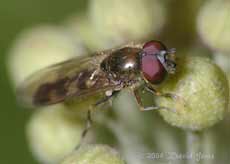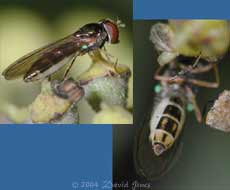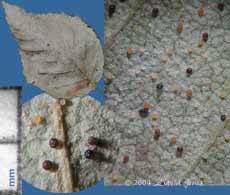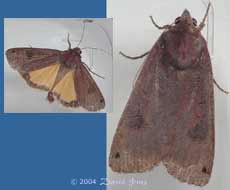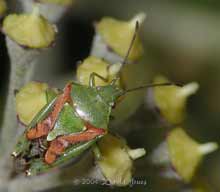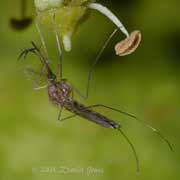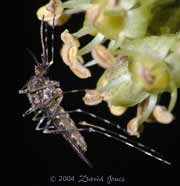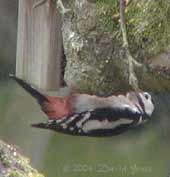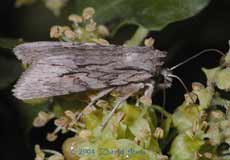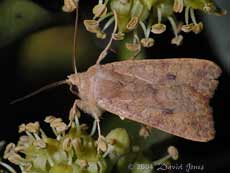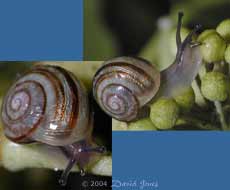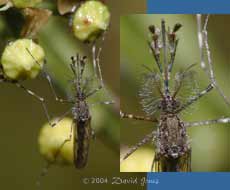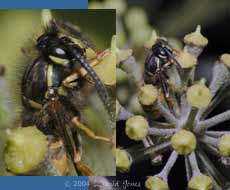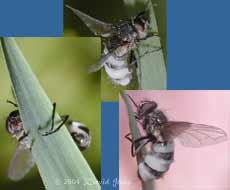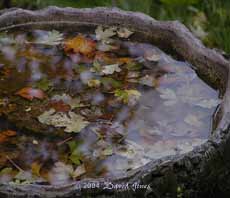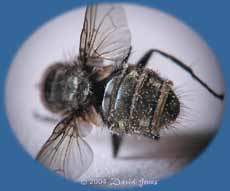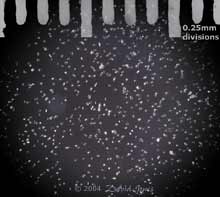Go to latest entry.....................................Go to previous entry16 October - The weather is very dull at the moment, although we have had only a couple of spots of rain over the last two days. Down at the Ivy, daytime activity continues, although last night I saw just one moth, another plume moth (Emmelina monodactyla). The wasps are as busy as ever at lunchtime today. I think this is a male Common Wasp (Vespula vulgaris) which is investigating a flower bud (measuring just under 4mm across). Despite all their frantic efforts at food gathering, nearly all these wasps will soon die as winter approaches, with only mated females living through the winter. Today, the Bluebottles continue to be the most obvious true flies on the flowers, and I only was a couple of hoverflies.
This is the the only image grabbed of the first one I saw. The close set eyes indicate that it is a male, but I am uncertain of the species. Notice the white colour of the haltere (balancing organ).
This second, female hoverfly (its eyes have a wide space between them) had a surprise for me when I looked at the images afterwards. Although I didn't notice it as I took the photographs, its halteres appear to be a bright turquoise blue, something I have not seen before. At first, I wondered if this had anything to do with reflections from the flash, but the colour appeared in all three photographs taken of the fly from different angles. Its abdomen appears distended, suggesting that it had been at the Ivy for a while. It turns out to be a female Melanostoma scalare, and despite my not having seen halteres like this before, is a very common hoverfly in gardens! I think that the male may be of the same species. Thanks to Hans Arentsen (of www.gardensafari.net) for identifying the species. He has a photograph of a similarly 'decorated' female on his site.
The young ones are white and the older ones are anything from orange through to black in colour.
Click on an image to see a larger version
17 October - Another dull day with just a few spots of rain. I was out most of the day, helping one of my sons. By the time I got home daylight was starting to fail. At 6.15pm it isn't dark yet but thanks to the cloud cover it is already pretty dim - I'm not looking forward to the end of the month when the clocks are put back to GMT.
I have yet to identify them, although they appear to be a species of Ink Cap fungus.
Last night's check of the Ivy revealed just one moth again, the same(?) plume moth that I have seen the last few nights.
18 October - Yesterday's cloud continued into the night, and that meant that the temperature, 10C at around 10pm must have been at least 3C warmer than the previous night, and it made a difference to activity around the Ivy. I spent a short time checking the tree and found that were were at least three Angle Shades, four plume moths (all Emmelina monodactyla), four Large Yellow Underwings, and another brown coloured moth that I couldn't get near to. There were also some mosquitoes and a shieldbug (see below)! There was also a hedgehog hunting in the garden again, but I have yet to manage a phototgraph.
It wasn't very cooperative, but I did manage one shot of the wings spread as it fluttered about at the top of a container. On this individual the hind wings were rather orange more than yellow.
Today has been bright and sunny, so the Ivy has been the centre of a lot of activity. Although the visitors were mainly the wasps etc that we have been seeing here frequently there seemed to be a greater variety of flies, including small parasitic types, although I didn't manage to photograph any.
It isn't a species that I can recall seeing here before, and a search of both the guide books and the web was needed to ID it as a Juniper Shieldbug (Elasmostethus tristriatus). I finally found a printed image of the species in a copy of the BBC Wildlife magazine of June 2004 where it says that it is normally found on 'Limestone hills on Juniper and elsewhere in parks and gardens on Lawson's cypress'.
Just after this photograph was taken a wasp landed on the same group of flower heads. The bug's reaction was to let go its grip and fall down to the undergrowth below.
19 October - In contrast to yesterday, this morning has started overcast and slightly damp. Yesterday's good weather continued into the late evening, and when I checked the Ivy after 10pm there was very little cloud cover. As a result it was cooler than the previous night, with the temperature below 7C, and I couldn't find any moths at all.
There were, however, numerous mosquitoes about, with a few in range of my camera. This one seems to have already had its fill, and was resting. I'm not able to identify it.
On the basis of the appearance of its antennae this one is, I think, Culex pipiens. Although at rest in this image, it's obvious from the slimness of its abdomen that it hasn't started feeding yet.
The third image is of a species I least like to encounter in the garden (or elsewhere) as I react quite badly to its bite. The boldly banded legs indicate that it is Culiseta annulata, one of our largest mosquitoes. It appears to be using its proboscis to probe an anther.
Sod's Law prevailed, and by the time I had collected my camera, sorted out the lens and got back to the window the bird had moved to the other side of the tree. This low quality image represents the only chance I had to get a picture of any kind.
Also making an appearance was this moth. I couldn't match it with anything in my guides so I turned to Mike Wall's excellent site which records moth sightings in Hampshire. The nearest match there is a moth called The Brick (Agrochola circellaris).
In addition to these moths there another which held its wings up like a butterfly, but which flew off before I could get close to it. There were also numerous Green Lacewings fluttering around and more mosquitoes than I saw last night.
This year I have seen few harvestmen, so it was almost a pleasant surprise to find this individual on the Ivy. The best match I can offer for this one is paroligolophus agrestis, a very common species that prefers to live in trees.
20 October - A wet day. This evening the rain stopped for a while, but with everything very wet I spent only a short time outside with my camera, which is not waterproof.
As if to take advantage of the wet conditions, this White-lipped Snail (I think) had climbed up to the flowers on the Ivy.
There were a couple of moths present when I checked at 8pm (2 Large Yellow Underwings, 1 Brick and 1 plume moth). There were numerous mosquitoes about and this one was posed so that its antennae showed up clearly - an impressive array!
22 October - The last two days have been dry. Yesterday was bright and breezy, but today it has been a miserably grey day and not quite so breezy. I haven't done much in the way of photography, but there have been a couple of things to note.
First, I had only brief look at the Ivy yesterday evening, soon after dark (after 7pm). I saw one Large Yellow Underwing moth, but more interesting was this wasp. There were quite a few about in the day, but this one had obviously visited around sunset as the temperature dropped, and decided to stay put for the night.
This afternoon I spotted this fly with broad white bands on its abdomen at the top of some grass by the pond. Closer inspection revealed that although it was clinging tightly to the grass it was in fact dead. After taking those pictures I settled down to read the November edition of the BBC Wildlife Magazine which arrived this morning.
By coincidence, there was an item on a page headed 'Strange but true' that describes exactly what has happened to this fly. I headed back out the garden to take more pictures only to find that the wind had dislodged it. A search of the undergrowth soon revealed it (thanks to the stripes) and I was able to take these extra images.
As it develops, the fungus forces the abdominal segments apart, creating the white bands. Spores are then released, to be carried away on the breeze where they can infect another fly!
The article names the fungus as a species of Entomophthora, and the fly is most likely to be a member of a large group, the Fanniidae (which includes the lesser housefly).
It is too wet to take the camera down the garden tonight - the rain is pouring down as I write this. I did venture out at about 8pm and the only creatures I found were our usual Orange ladybirds (I counted twelve) on the Birch, sheltering on the undersides of leaves.
Here indoors I have taken another photograph of the fly pictured yesterday. By this morning the white bands had completely gone, the shedding of spores having been completed, and its abdomen has returned to an almost normal appearance.
The container that the fly had been kept in overnight now has a powdering of spores over its lower surface. I have included this image with a scale superimposed to try to give an idea of their size.
Click on images to see larger versions |
|

